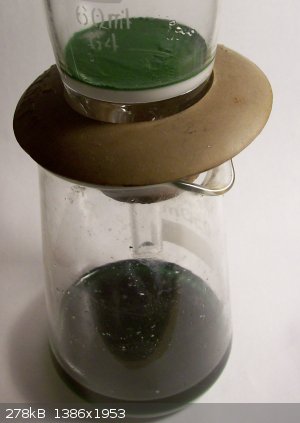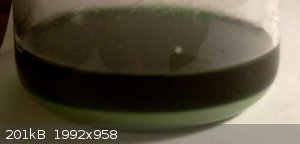| Pages:
1
2 |
Tsjerk
International Hazard
    
Posts: 3032
Registered: 20-4-2005
Location: Netherlands
Member Is Offline
Mood: Mood
|
|
I would try if it works, maybe your Cr(VI) is already acidic enough and you won't have to use an acid. Only a small amount of acid is needed, Cr(VI)
has a nice red color, if it turns green; no acid needed. If it doesn't you have to add a bit of acid. Can you get ascorbic acid? That is an acid and a
reductor.
|
|
|
artemov
Hazard to Others
  
Posts: 181
Registered: 22-8-2018
Member Is Offline
|
|
Quote: Originally posted by Tsjerk  | | I would try if it works, maybe your Cr(VI) is already acidic enough and you won't have to use an acid. Only a small amount of acid is needed, Cr(VI)
has a nice red color, if it turns green; no acid needed. If it doesn't you have to add a bit of acid. Can you get ascorbic acid? That is an acid and a
reductor. |
Thanks Tsjerk, I dun have ascorbic acid ... and it's probably too expensive to be used this way lol ... I think my dichromate solution has a pH
between 2 and 3 ... I'll add just a bit more sulfuric acid to be sure.
|
|
|
wg48temp9
National Hazard
   
Posts: 784
Registered: 30-12-2018
Location: not so United Kingdom
Member Is Offline
|
|
So I decided to terminate my "how many years does it take to dissolve green chromium oxide in battery acid" experiment. On examining the flask it
looked like a significant portion of the oxide had desolved and it was just possible to make out a purple solution through the now stirred up green
oxide.
So I decided to reduce the volume of the solution on a 110C hot plate. After about a day I was left with a dark green sludge that appeared to contain
crystals several millimeters across. So I diluted the sludge to dissolve the crystals and gravity filtered it. Eventually on the hot plate to speed
up the filtration. That produced a clear dark green solution. which on cooling deposited a whitish sludges.
I assume there was only chromium, sulphate ions.and dilute sulphuric acid in the solution. So can any one suggest what the whitish sludge may be?
How long does the green solution take to turn back to purple?
I guess I will have to filter it again preferably vacuum filtration this time with my now green sintered filter funnel (G4 ).


I am wg48 but not on my usual pc hence the temp handle.
Thank goodness for Fleming and the fungi.
Old codger' lives matters, wear a mask and help save them.
Be aware of demagoguery, keep your frontal lobes fully engaged.
I don't know who invented mRNA vaccines but they should get a fancy medal and I hope they made a shed load of money from it.
|
|
|
valeg96
Hazard to Others
  
Posts: 254
Registered: 6-4-2014
Location: Italy
Member Is Offline
Mood: Moodless
|
|
I'm not an expert but Chromium sulphate exists in plenty hydrated forms. The 18-hydrate is purple, the 9-hydrate is purple, the 3-hydrate is green and
the anhydrous salt is pinkish and insoluble. Chromium sulphate probably also has a decent array of basic salts, and heating to boiling temperatures
these solutions is rarely a good way to isolate a solid.
I'd try to isolate that insoluble matter, wash it and see if it is the insoluble anhydrous sulphate.
https://www.chemguide.co.uk/inorganic/transition/chromium.ht...
|
|
|
wg48temp9
National Hazard
   
Posts: 784
Registered: 30-12-2018
Location: not so United Kingdom
Member Is Offline
|
|
Quote: Originally posted by valeg96  | I'm not an expert but Chromium sulphate exists in plenty hydrated forms. The 18-hydrate is purple, the 9-hydrate is purple, the 3-hydrate is green and
the anhydrous salt is pinkish and insoluble. Chromium sulphate probably also has a decent array of basic salts, and heating to boiling temperatures
these solutions is rarely a good way to isolate a solid.
I'd try to isolate that insoluble matter, wash it and see if it is the insoluble anhydrous sulphate.
https://www.chemguide.co.uk/inorganic/transition/chromium.ht... |
Thanks for the input. I guess it could be a pinkish white color with the pinkish color masked by the green solution. Yes I will attempt to isolate the
whitish sludge.
Water solutions on that hot plate (actually a temperature controlled slow cooker hot plate) do not boil but they do evaporate slowly. Its a
convenient and unattended way to reduce a water solution admittedly very slowly with almost no chance of over heating (>110C) or getting a
chromium containing aerosol but plenty of time to observe changes.
I am wg48 but not on my usual pc hence the temp handle.
Thank goodness for Fleming and the fungi.
Old codger' lives matters, wear a mask and help save them.
Be aware of demagoguery, keep your frontal lobes fully engaged.
I don't know who invented mRNA vaccines but they should get a fancy medal and I hope they made a shed load of money from it.
|
|
|
valeg96
Hazard to Others
  
Posts: 254
Registered: 6-4-2014
Location: Italy
Member Is Offline
Mood: Moodless
|
|
To provide controlled heating you should evaporate water on a water bath; that way you can be sure the beaker is being heated at 100°C.
On a hotplate, the beaker has hot spots where the solution gets heated excessively. The same thing happens if you try to boil down a solution of
copper nitrate; the insoluble light blue basic copper nitrate will precipitate upon overheating.
Preparative inorganic chemistry books sometimes remind you not to heat Cr(III) salts in solution, as you could degrade your reagent to an insoluble
salt (like chromium sulphate) or undesired isomers (like chromium chloride hydrates). On the other hand, I've seen syntheses that start from those
salts, and instruct you to make them by heating the hydrated salts.
|
|
|
wg48temp9
National Hazard
   
Posts: 784
Registered: 30-12-2018
Location: not so United Kingdom
Member Is Offline
|
|
So I poured off most of the clear dark green solution and attempted to resuspend the whitish gunge by swirling it in about three times its volume
of water it but rapidly dissolved into a clear green solution. I think valeg96 is probably correct it is an anhydrous salt or a low hydrate salt
but it IS soluble.
Its surprising even if the original volume of the dark green solution was all sulphuric acid, after water was added it can be no more than 30% acid
and probably much less.
I will repeat the synthesis of the gunge to check the results are reproducible and perhaps try to wash it with a suitable organic solvent.
I am wg48 but not on my usual pc hence the temp handle.
Thank goodness for Fleming and the fungi.
Old codger' lives matters, wear a mask and help save them.
Be aware of demagoguery, keep your frontal lobes fully engaged.
I don't know who invented mRNA vaccines but they should get a fancy medal and I hope they made a shed load of money from it.
|
|
|
Amos
International Hazard
    
Posts: 1406
Registered: 25-3-2014
Location: Yes
Member Is Offline
Mood: No
|
|
If anyone is still trying to prepare chromium sulfate and just getting a dark green syrup, I've found that instead of waiting for the problem to
resolve itself, it is far more helpful to just precipitate all the chromium out as the basic sulfate by addition of NaHCO3 solution, wash and filter
the bluish grey precipitate out, then dissolve it in just enough cold dilute sulfuric acid, which isn't instantaneous but rather takes a few minutes
of patience.
The resulting solution is blue-violet and has no hygroscopic character whatsoever; simply evaporate it and you'll eventually get an ugly blue-grey
solid forming at the bottom that looks just like the wikipedia picture. I'm not entirely certain which hydrate this is; it may depend on your relative
humidity. Anyway, form a saturated solution in cold water and add to your fairly concentrated potassium sulfate solution, and tomorrow you've got
chrome alum crystals.
[Edited on 12-29-2020 by Amos]
|
|
|
| Pages:
1
2 |